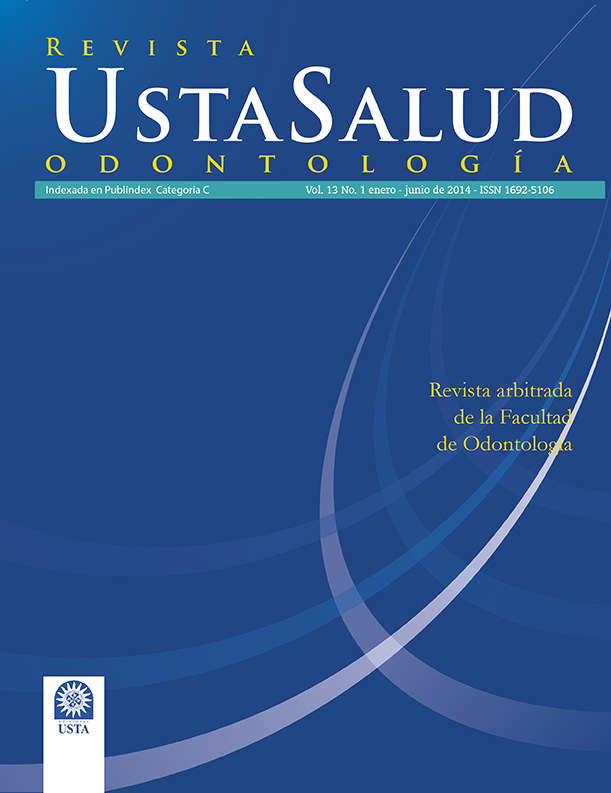PROPIEDADES FÍSICO-MECÁNICAS Y TIPO DE FALLA ADHESIVA DEL ESMALTE HUMANO Y BOVINO
Resumen
Objetivo: comparar la fuerza de adhesión y tipo de falla entre el esmalte humano y bovino mediante el dispositivo universal de pruebas y estereomicroscopía.
Materiales y métodos: se realizó un estudio experimental In vitro para lo cual se utilizaron sesenta dientes, treinta primeros premolares superiores humanos y treinta incisivos inferiores bovinos en los cuales se cementaron brackets estándar metálicos (Ortho Organizers, California, EE. UU.) con resina compuesta (Transbond® XT, 3M Unitek, St. Paul, Minnesota, EE. UU.). Posteriormente, fueron descementados usando un dispositivo universal de pruebas (Instron 3367 Class 0,5 with load cell 0-30Kn, EE. UU.) a una velocidad de 1,5 mm/min. Los datos fueron calculados en megapascales al dividir la fuerza por el área de la base del bracket. Para determinar el tipo de falla, la superficie de los dientes y las bases de los brackets fueron analizados mediante inspección visual con un estereomicroscopio (Stemi 2000C, Carl Zeiss, Göttingen, Germany).
Resultados: la fuerza de adhesión en dientes bovinos fue mayor al compararla con los dientes humanos (12,11 MPa y 6,10 Mpa, respectivamente) sin presentarse una diferencia estadísticamente significativa (p=0,052). Los tipos de falla predominantes para humanos y bovinos se presentaron en la interfase Resina/Bracket (RB 60,71%) y Adhesivo/Esmalte (AE 57,14%). El análisis de correspondencia múltiple reportó que a cualquier valor de fuerza se puede presentar cualquier tipo de falla en ambos dientes.
Conclusión: aunque no se encontró una diferencia significativa entre los grupos, no es concluyente la utilización de los dientes bovinos como sustitutos de dientes humanos en estudios de adhesión a esmalte según el método utilizado en esta investigación.
[Benitez M, Mirxoyan A, Rivera JR, Tanaka EM. Propiedades físico-mecánicas y tipo de falla adhesiva del esmalte humano y bovino. Ustasalud. 2014; 13: 11 - 17]
Referencias
2. Lunardi N, Gameiro H, Borges M, Nouer D, Vieira V, Consani S, Sarmento J. The effect of repeated bracket recycling on the shear bond strength of different orthodontic adhesives. Braz J Oral Sci. 2008; 7: 1648 - 1652.
3. Nkenke E, Hirschfelder U, Martus F, Eberhard H. Evaluation of the bond strength of different bracket-bonding systems to bovine enamel. Eur J Orthod. 1997; 19: 259 - 270.
4. Oshiro J, Medici E, Pereira J, Castillo M. Comparative analysis of human and bovine teeth: radiographic density. Braz Oral Res. 2008; 22: 346 - 351.
5. Posada M, Sánchez C, Gallego G, Vargas A, Restrepo L, López J. Dientes de bovino como sustituto de dientes humanos para su uso en odontología. Revisión de la literatura. Rev CES Odontol. 2006; 19: 63 - 68.
6. Nakamichi I, Iwaku M, Fusayama T. Bovine teeth as possible substitute in adhesion test. J Dent Res. 1983; 62: 1076 - 1083.
7. Fowler C, Swartz M, Moore B, Rhodes B. Influence of selected variables on adhesion testing. Dent Mater. 1992; 8: 265 - 269.
8. Oesterle L, Shellhart W, Belanger G. The use of bovine enamel in bonding studies. Am J Orthod Dentofacial Orthop. 1998; 113: 514 - 519.
9. Grassi L, Canhizares C, Barbosa R, Guaglianoni D, Pereira L. Human teeth versus bovine teeth: cutting effectiveness of diamond burs. Braz J Oral Sci. 2010; 9: 39 - 42.
10. White A, Yorath C. Human and bovine enamel erosion under single drink conditions. Eur J Oral Sci. 2010; 118: 604 - 609.
11. Georgia’s Health Science University-School of Dentistry. Bond failure analysis. January 2003.
12. Ciceri A, Monroy J, Ardila G, Luna A, Rivera J. Comparación de la fuerza adhesiva y el tipo de falla de dos sistemas adhesivos para ortodoncia. Ustasalud. 2011; 10: 29 - 35.
13. Polat O, Karaman A, Buyukyilmaz T. In vitro evaluation of shear bond strengths and In vivo analysis of bond survival of indirect-bonding resins. Angle Orthod. 2004; 74: 405 - 409.
14. Sfondrini M, Scribante A, Cacciafesta V, Gandini P. Shear bond strength of deciduous and permanent bovine enamel. J Adhes Dent. 2011; 13: 227 - 230.
15. Klocke A, Kahl-Niekeb B. Influence of the force location in orthodontic shear bond strength testing. Dent Mater. 2005; 21: 391 - 396.
16. Klocke A, Kahl-Niekeb B. Effect of debonding force direction on orthodontic shear bond strength. Am J Orthod Dentofacial Orthop. 2006; 129: 261 - 265.
17. Vilar R, Souza N, Cal-Neto J, Galvao M, Sampaio H, Moraes A. Shear bond strength of brackets bonded with two light-curing orthodontic adhesives. J Adhes Dent. 2009; 11: 259 - 262.
18. Fernández L, Canut J. In vitro comparison of the retention capacity of new aesthetic brackets. Eur J Orthod. 1999; 11: 71 - 77.
19. Pickett K, Sadowsky L, Jacobson A, Lacefield W. Orthodontic in vivo bond strength: comparison with In vitro results. Angle Orthod. 2001; 71: 141 - 148.















